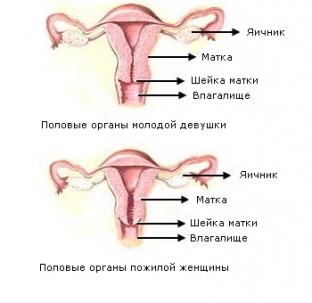The period of menopause is a very important stage in the life of every woman, since physiological changes in the functioning of the reproductive system occur in her body at this time, affecting the activity of the whole organism. After menopause, a woman's ovaries reduce the synthesis of reproductive hormones, which affect the functioning of many other systems in the female body. But the most pronounced changes under the influence of hypoestrogenism are observed, of course, in the uterus and ovaries. Since various pathological processes can occur against this background, knowledge of what happens in the internal genital organs of a woman after menopause is of particular value.
Characteristic changes in the internal genital organs after menopause
The most pronounced involutive processes after menopause occur precisely in the internal genital organs of a woman. The uterus is a target organ for sex hormones, and due to the hypoestrogenism that occurs after menopause, it loses about 35% of its volume, which is associated with the development of atrophic processes in its tissues. Today, it is possible to control the changes occurring in the internal genital organs of a woman using new effective research methods, such as ultrasound, dopplerography, hydrosonography, hysteroscopy, magnetic resonance imaging, and so on. Using these methods, it is possible to study all involutive changes in the uterus and ovaries throughout the entire postmenopausal period.
Changes after menopause:
- what changes occur in the myometrium after menopause;
- characteristic changes in the endometrium after menopause;
- how changes in hormonal levels after menopause affect the ovaries;
- preventive diagnosis after menopause is the best way to protect against diseases.
What changes occur in the myometrium after menopause
A significant percentage of its volume after menopause, the uterus loses primarily due to involutive processes in the myometrium.

The most pronounced atrophic processes in it during the first 2-5 years after menopause. The echogenicity of the myometrium in the first years after menopause is average, and it increases with an increase in the duration of the postmenopausal period. There are fibrotic changes in the myometrium in the form of the appearance of multiple hyperechoic areas in it. According to the Doppler study, a significant depletion of blood flow in the peripheral layers of the myometrium is recorded. At the same time, if a woman had fibroids before menopause, they also undergo involution after menopause.
Characteristic changes in the endometrium after menopause
Endometrium after menopause also undergoes involutive processes. If before the onset of menopause, the endometrium constantly undergoes cyclic changes under the influence of reproductive hormones, then after menopause it generally atrophies. Due to atrophy of the endometrium, the longitudinal and transverse dimensions of the uterine cavity are significantly reduced. With a long postmenopausal period, endometrial atrophy may be accompanied by the formation of synechia, which, according to ultrasound, are recorded as linear inclusions of increased echo density. After menopause, there is a significant narrowing of the lumen of the cervical canal, up to its complete fusion. As a result, a small amount of fluid may accumulate in the uterine cavity, which is not a pathology.
How changes in hormonal levels after menopause affect the ovaries
Changes in hormonal levels after menopause are also reflected in the structure of the ovaries themselves. In postmenopause, their volume and size are significantly reduced, and changes in the echostructure of the ovaries are also observed. There are two main types of postmenopausal changes in the ovaries:
- with changes of the atrophic type - there is a significant decrease in the volume and size of the ovaries;
- with changes of the hyperplastic type - the size of the ovaries decreases gradually and rather slowly, the formation of small liquid inclusions in them is possible.
Prophylactic diagnosis after menopause is the best way to protect against diseases
Today, the use of highly informative diagnostic methods allows timely detection and elimination of any pathological processes that occur in the genital organs of a woman after menopause. It is necessary to inform all women of this age group in a timely and detailed manner about the need for such studies. The most effective method of treating menopausal manifestations that occur after menopause is the appointment of hormone replacement therapy, the possible and rather rare side effects of which can only be prevented through competent individual selection of a therapeutic regimen.






Add a comment